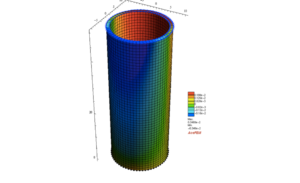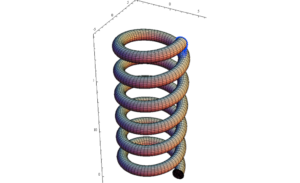Different aspects have been addressed, such as rate-dependent behavior, two-way shape memory effect, permanent inelasticity, asymmetry and phase dependent properties, cyclic loading of wires, beam structural models, finite-strain extensions, numerical implementation details ([P1-2]). More recently, contributions have been also devoted to include martensite variant reorientation mechanisms ([P3-4]) also in a finite-strain constitutive model context ([P5]). Several papers have also been devoted to the study of SMA industrial applications in different fields, e.g., structural engineering, earthquake engineering ([P6]), biomedical engineering ([P7-8-9]). Some of the proposed models are currently the most widely implemented in commercial codes (among others, Abaqus, Ansys, FEAP, LSDyna, etc). Thanks to the collaboration with companies, such as SAES Getters, experimental data on SMA testing and manufacturing procedures can be obtained and used both for model validation and for investigation of new modeling routes.
Group publications
[P1] F. Auricchio, L. Petrini. 2004. A three-dimensional model describing stress-temperature induced solid phase transformations. Part I: solution algorithm and boundary value problems. International Journal for Numerical Methods in Engineering, 61:807-836.
[P2] F. Auricchio, L. Petrini. 2004. A three-dimensional model describing stress-temperature induced solid phase transformations. Part II: thermomechanical coupling and hybrid composite applications. International Journal for Numerical Methods in Engineering, 61:716-737.
[P3] Arghavani J., F. Auricchio, R. Naghdabadi, A. Reali, S. Sohrabpour. 2010. “A 3D phenomenological constitutive model for shape memory alloys under multiaxial loadings”. International Journal of Plasticity, 26: 976-991.
[P4] Arghavani J., F. Auricchio, R. Naghdabadi, A. Reali, S. Sohrabpour. 2010. “A 3D finite strain phenomenological constitutive model for shape memory alloys considering martensite reorientation”. Continuum Mechanics and Thermodynamics, 22: 345-362.
[P5] Arghavani J., F. Auricchio, R. Naghdabadi. 2011. “A finite strain kinematic hardening constitutive model based on Hencky strain: general framework, solution algorithm and application to shape memory alloys”. International Journal of Plasticity, 27: 940-961.
[P6] Attanasi G., F. Auricchio, G.L. Fenves. 2009. “Feasibility investigation of superelastic effect devices for seismic isolation applications”. Journal of Materials Engineering and Performance, 18: 729-737.
[P7] Auricchio F., A. Reali. 2008. “Shape Memory Alloys: Material Modeling and Device Finite Element Simulations”. Materials Science Forum, 583: 257-275.
[P8] Auricchio F., A. Reali, A. Tardugno. 2010. “Shape-memory alloys: effective 3D modeling, computational aspects and design of devices”. International Journal of Computational Materials Science and Surface Engineering, 3: 199-223.
[P9] Auricchio F., M. Conti, S. Morganti, A. Reali. 2010. “Shape Memory Alloy: from constitutive modelling to finite element analysis of stent deployment”. Computer Modeling in Engineering & Sciences, 57: 225-243.



